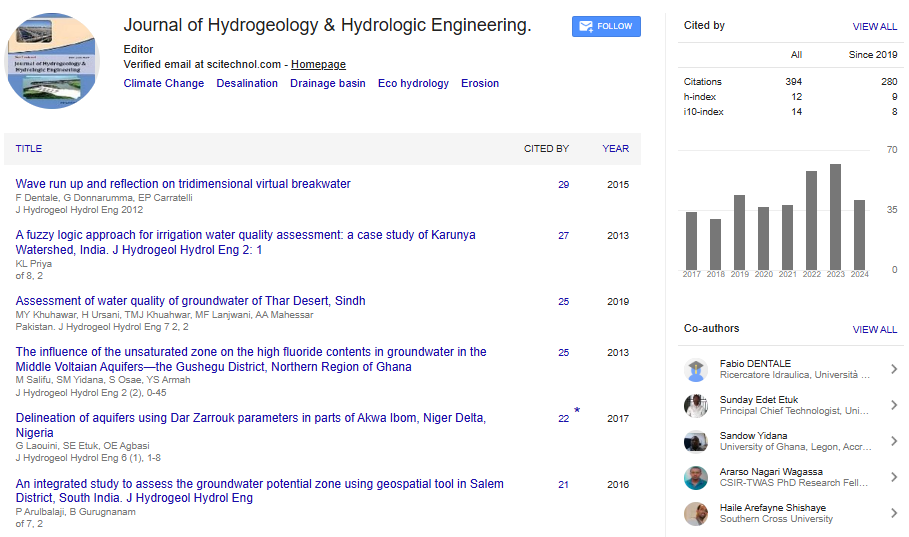Opinion Article, J Hydrogeol Hydrol Eng Vol: 13 Issue: 4
Enhancing Water Management with Hydroinformatics Innovations
Kaisheng Luo*
1Department of Environmental Science, University of Pretoria, Pretoria, South Africa
*Corresponding Author: Kaisheng Luo,
Department of Environmental Science,
University of Pretoria, Pretoria, South Africa
E-mail: amerys458@gmail.com
Received date: 29 July, 2024, Manuscript No. JHHE-24-149250;
Editor assigned date: 31 July, 2024, PreQC No. JHHE-24-149250 (PQ);
Reviewed date: 14 August, 2024, QC No. JHHE-24-149250;
Revised date: 21 August, 2024, Manuscript No. JHHE-24-149250 (R);
Published date: 29 August, 2024, DOI: 10.4172/2325-9647.100033
Citation: Amery S (2024) Enhancing Water Management with Hydroinformatics Innovations. J Hydrogeol Hydrol Eng 13:4.
Description
Hydroinformatics is an interdisciplinary field that integrates water sciences with advanced data analysis, modeling and computational techniques. By exploiting modern technologies, hydroinformatics enables more efficient water resource management and addresses complex challenges related to hydrological systems, water quality and environmental sustainability.
With increasing urbanization, climate change and population growth, the demand for sustainable water management has escalated. Traditional methods of managing water resources often struggle to cope with the dynamic changes in weather patterns, water availability and pollution. Hydroinformatics steps in as a solution, combining computational methods, hydrology and engineering to create tools that allow for accurate prediction, monitoring and management of water systems.
One of the primary advantages of hydroinformatics lies in its ability to handle large datasets. As sensors, satellites and other data-gathering tools become more advanced, the volume of information available for decision-making grows exponentially. Hydroinformatics uses this data to provide real time analysis and long-term projections for water resources, giving stakeholders such as governments, utilities and environmental organizations the ability to make more informed decisions.
Floods are one of the most devastating natural disasters, affecting millions of people each year. Through the use of models and simulations, hydroinformatics helps predict flood events with greater accuracy, providing early warnings that can save lives and reduce damage. These models can also assist in designing better flood control infrastructure, such as levees and dams, by analyzing how different structures will perform under varying conditions.
Cities and towns rely on vast networks of pipelines, pumps and reservoirs to deliver clean water to residents. Hydroinformatics helps optimize the operation of these systems, reducing energy consumption and preventing losses due to leaks or inefficiencies. By integrating real-time data from sensors installed throughout the network, engineers can quickly respond to any anomalies and maintain the integrity of the system.
Maintaining water quality is a major concern for both human consumption and ecological health. Hydroinformatics enables continuous monitoring of key indicators such as pH levels, turbidity and contaminants. By automating data collection and analysis, hydroinformatics reduces the need for manual sampling and makes it easier to detect potential issues before they become widespread.
Groundwater plays a vital role in supplying water for agriculture, industry and domestic use. Hydroinformatics helps model the flow and storage of groundwater, providing insights into the sustainability of aquifers. With the help of these tools, water managers can develop strategies to prevent over-extraction and protect groundwater reserves for future generations.
As global temperatures rise, hydroinformatics becomes increasingly valuable in managing the impacts of climate change on water resources. It assists in forecasting changes in precipitation patterns, sea levels and the frequency of extreme weather events. By analyzing different climate scenarios, hydroinformatics helps policymakers design strategies that ensure water availability in both the short and long term.
Machine learning and Artificial Intelligence (AI) are revolutionizing the capabilities of hydroinformatics. By training algorithms on large datasets, these technologies can identify patterns and trends that may not be apparent through traditional methods. For instance, AI can improve the accuracy of hydrological models by continuously learning from new data inputs, thus providing more reliable forecasts over time.
Moreover, machine learning can be used to automate processes such as anomaly detection in water quality or network performance, allowing for faster and more efficient responses. As these technologies evolve, they are expected to play an even larger role in the future of hydroinformatics.
Conclusion
Hydroinformatics represents a powerful tool for addressing the complexities of water management in an ever-changing world. By integrating advanced data analysis, modeling and computational techniques, it offers innovative solutions for flood prediction, water quality monitoring and resource optimization. As technology continues to advance, hydroinformatics will remain at the lead of efforts to manage water resources more sustainably, ensuring that this vital resource is available for both current and future generations.
 Spanish
Spanish  Chinese
Chinese  Russian
Russian  German
German  French
French  Japanese
Japanese  Portuguese
Portuguese  Hindi
Hindi 
